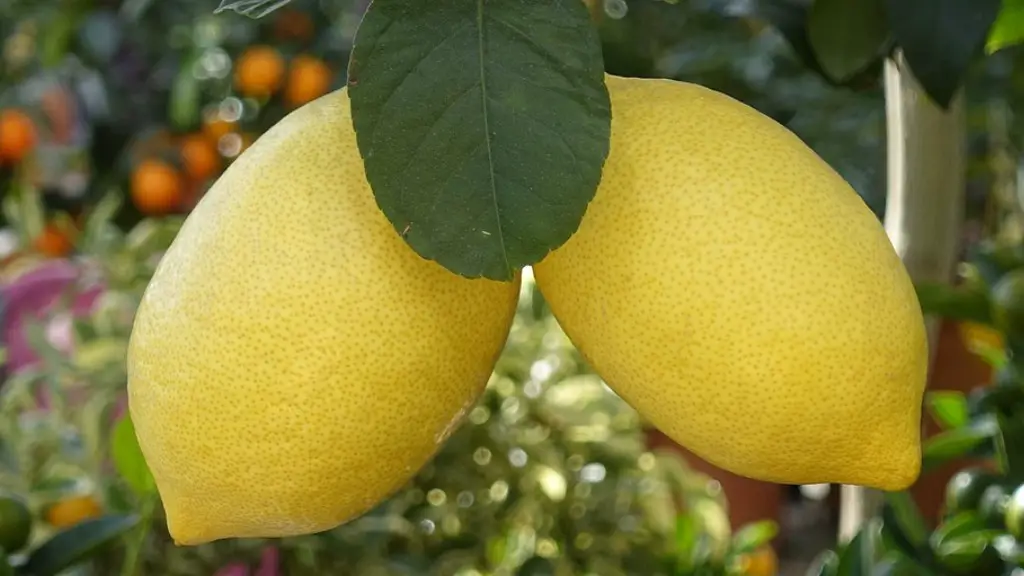Planting a lemon tree in the ground may seem intimidating, but it doesn’t have to be. With the right preparation and knowledge, anyone can successfully plant a lemon tree. To get started, gather the necessary materials such as sandy loam soil, slow-release fertilizer, and a tree that is adaptable to local climate. Once gathered, locate a well-drained spot in your yard. This area should get at least 8 hours of direct sunlight daily.
To begin planting, dig a hole large enough for the lemon tree’s root system. The hole should be about two feet deep and two feet wide. Be sure to make it wider than the tree’s root system – this will encourage the roots to spread out and give the plant a stronger foundation. After the hole is dug, add a layer of sandy loam soil to the bottom of the hole. This soil will give the tree the excellent drainage it needs.
Mix the regular soil with the loose, sandy loam soil; aim for at least 2-3 inches of sandy loam soil throughout the hole. Carefully lower the lemon tree into the hole. The top of the tree’s root system should be flush with the ground level. Afterward, begin to fill the hole around the tree with the soil mixture, tamping lightly to remove air pockets.
Once the soil is packed around the tree firmly, it’s time to water the soil. Make sure to give the tree a good amount of groundwater, but be careful not to over-water. Water every two-four days for the first month; you can decrease watering frequency as the tree becomes established. After that, water the tree every 10 days or when the soil is dry.
Finally, add a layer of slow-release fertilizer around the tree’s base. This will give the tree an initial boost and the essential nutrients it needs to survive and thrive. There you have it – your own lemon tree planted in the ground. Now all that’s left to do is enjoy the fruit of your labor!
Taking Care of your Lemon Tree
Taking care of your newly planted lemon tree is essential for its success and growth. During initial flowering and fruit production – known as bearing – be sure to water and fertilize regularly. Most soils require moderate to high levels of irrigation and fertilization, so always check and adjust accordingly.
Caring for the lemon tree includes providing essential nutrients. Mulching is an excellent way to fertilize the soil as it provides extra nitrogen, potassium and phosphorus to the soil. This is especially important in clay soils because they are slow to release nutrients and need frequent replenishment.
You can also provide some additional protection to the tree against harsh conditions. For example, if the weather gets too hot or cold, provide shade with a tarp or other material. This will reduce direct sunlight and help the tree survive colder or hotter temperatures.
Finally, pruning is also important to maintain the health and structure of the tree. Trim any dead or excess growth, and also ensure that the branches are evenly spread out across the canopy. This will allow for more sunlight penetration and more fruit production.
When to Water and Fertilize
The best time to water and fertilize your lemon tree is when the soil is dry. Generally, it is safe to water about once every 7-10 days for the first month and then reduce it to about once every 3-4 weeks. Be careful to not over-water – this can stress the tree and damage the root system.
Fertilizing is also important for a happy and healthy tree. During the growing season – generally March through September – use a slow-release or organic fertilizer once or twice a month. Check with your local garden center or nursery for the specific type and amount of fertilizer best suited for your soil and climate.
Remember to always water and fertilize the soil around the tree – not the leaves or fruits. Putting water and fertilizer directly on the tree can cause plant burn or other damage.
Common Lemon Tree Diseases
Though planting a lemon tree is relatively straightforward, there are some common diseases to look out for. Citrus canker is a common disease that causes lesions on the leaves and stems of the tree. It is important to quarantine any infected trees to prevent the spread of the disease.
Another common disease is citrus greening. This is caused by a bacterial insect and usually affects younger trees more than mature ones. There is still no cure for this disease, but it can be prevented by providing ample water, nutrition, and pest control.
Finally, root rot is also a problem that can occur in lemon trees. This is caused by fungus and can be avoided by avoiding waterlogged soil and getting rid of any extra water quickly. A healthy drainage system and keeping the soil pH balanced can also help prevent root rot.
Pests Affecting Lemon Trees
Pests can also be an issue when it comes to growing lemon trees. Aphids can suck on the leaves and stems of trees, causing discoloration and leaf drop. To get rid of these pests, be sure to spray the tree with neem oil every few weeks. Spider mites can also cause damage to the tree and can be treated with insecticidal soap.
Citrus leafminer is another pest that can cause yellow spots and brown streaks on the leaves. The best way to get rid of these pests is to prune any infected branches and spray the tree with neem oil. Finally, scale and mealybugs can also damage the tree; these can be controlled by spraying with pesticide soap and oil.
To ensure that your lemon tree is healthy and happy, be sure to always inspect your tree for any signs of pests and disease. If you catch any issues early, they can be much easier to treat.
Harvesting and Enjoying your Lemons
When you have successfully planted and taken care of your lemon tree, you can look forward to harvesting and enjoying your lemons. Generally, the fruits will be ready to harvest after six-nine months depending on the location. Look for the lemons to be a pale yellow when they’re ripe and ready to pick.
When you’re ready to enjoy your lemons, you can use them in a variety of ways. They are great for baking and making jams, sauces, and other desserts, as well as for adding flavor to savory dishes. Additionally, the juice is a popular ingredient in cocktails and drinks such as lemonade and margaritas. Or simply enjoy lemons slices as a healthy and tasty snack!
Conclusion
Though planting a lemon tree may seem daunting, it doesn’t have to be. With the right knowledge and preparation, anyone can enjoy the fruits of their labor. And with proper care and maintenance, you can enjoy your lemons for many years to come.



